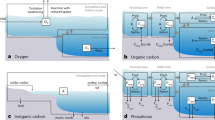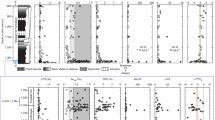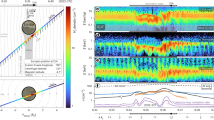Abstract
Earth’s modern atmosphere is highly oxygenated and is a remotely detectable signal of its surface biosphere. However, the lifespan of oxygen-based biosignatures in Earth’s atmosphere remains uncertain, particularly for the distant future. Here we use a combined biogeochemistry and climate model to examine the likely timescale of oxygen-rich atmospheric conditions on Earth. Using a stochastic approach, we find that the mean future lifespan of Earth’s atmosphere, with oxygen levels more than 1% of the present atmospheric level, is 1.08 ± 0.14 billion years (1σ). The model projects that a deoxygenation of the atmosphere, with atmospheric O2 dropping sharply to levels reminiscent of the Archaean Earth, will most probably be triggered before the inception of moist greenhouse conditions in Earth’s climate system and before the extensive loss of surface water from the atmosphere. We find that future deoxygenation is an inevitable consequence of increasing solar fluxes, whereas its precise timing is modulated by the exchange flux of reducing power between the mantle and the ocean–atmosphere–crust system. Our results suggest that the planetary carbonate–silicate cycle will tend to lead to terminally CO2-limited biospheres and rapid atmospheric deoxygenation, emphasizing the need for robust atmospheric biosignatures applicable to weakly oxygenated and anoxic exoplanet atmospheres and highlighting the potential importance of atmospheric organic haze during the terminal stages of planetary habitability.
This is a preview of subscription content, access via your institution
Access options
Access Nature and 54 other Nature Portfolio journals
Get Nature+, our best-value online-access subscription
$29.99 / 30 days
cancel any time
Subscribe to this journal
Receive 12 print issues and online access
$259.00 per year
only $21.58 per issue
Buy this article
- Purchase on SpringerLink
- Instant access to full article PDF
Prices may be subject to local taxes which are calculated during checkout




Similar content being viewed by others
Data availability
The data obtained by the statistical analysis are available to download at https://doi.org/10.6084/m9.figshare.13487487.v1. Source data are provided with this paper.
Code availability
Our Fortran source code is available at https://github.com/kazumi-ozaki/lifespan.
References
Fujii, Y. et al. Exoplanet biosignatures: observational prospects. Astrobiology 18, 739–778 (2018).
An Astrobiology Strategy for the Search for Life in the Universe (National Academies, 2019).
The LUVOIR Team. The LUVOIR Mission Concept Study Final Report. Available at https://asd.gsfc.nasa.gov/luvoir/reports/ (2019).
Meadows, V. S. et al. Exoplanet biosignatures: understanding oxygen as a biosignature in the context of its environment. Astrobiology 18, 630–662 (2018).
Schwieterman, E. W. et al. Exoplanet biosignatures: a review of remotely detectable signs of life. Astrobiology 18, 663–708 (2018).
Meadows, V. Reflections on O2 as a biosignature in exoplanetary atmospheres. Astrobiology 17, 1022–1052 (2017).
Wordsworth, R. & Pierrehumbert, R. Abiotic oxygen-dominated atmospheres on terrestrial habitable zone planets. Astrophys. J. Lett. 785, L20 (2014).
Gao, P., Hu, R., Robinson, T. D., Li, C. & Yung, Y. L. Stability of CO2 atmospheres on desiccated M dwarf exoplanets. Astrophys. J. 806, 249 (2015).
Luger, R. & Barnes, R. Extreme water loss and abiotic O2 buildup on planets throughout the habitable zones of m dwarfs. Astrobiology 15, 119–143 (2015).
Prentice, I. C. et al. in Climate Change 2001: The Scientific Basis (eds Houghton, J. T. et al.) 183–238 (IPCC, Cambridge Univ. Press, 2001).
Lyons, T. W., Reinhard, C. T. & Planavsky, N. J. The rise of oxygen in Earth’s early ocean and atmosphere. Nature 506, 307–315 (2014).
Lenton, T. M. et al. Earliest land plants created modern levels of atmospheric oxygen. Proc. Natl Acad. Sci. USA 113, 9704–9709 (2016).
Krause, A. J. et al. Stepwise oxygenation of the paleozoic atmosphere. Nat. Commun. 9, 4081 (2018).
Lenton, T. M. Gaia and natural selection. Nature 394, 439–447 (1998).
Lenton, T. M., Crouch, M., Johnson, M., Pires, N. & Dolan, L. First plants cooled the Ordovician. Nat. Geosci. 5, 86–89 (2012).
Caldeira, K. & Kasting, J. F. The life span of the biosphere revisited. Nature 360, 721–723 (1992).
Lovelock, J. E. & Whitfield, M. Life span of the biosphere. Nature 296, 561–563 (1982).
Franck, S., Bounama, C. & von Bloh, W. Causes and timing of future biosphere extinctions. Biogeosciences 3, 85–92 (2006).
Franck, S., Kossacki, K. J., Von Bloth, W. & Bounama, C. Long-term evolution of the global carbon cycle: historic minimum of global surface temperature at present. Tellus B 54, 325–343 (2002).
O’Malley-James, J. T., Greaves, J. S., Raven, J. A. & Cockell, C. S. Swansong biospheres: refuges for life and novel microbial biospheres on terrestrial planets near the end of their habitable lifetimes. Int. J. Astrobiol. 12, 99–112 (2013).
Walker, J. C. G., Hays, P. B. & Kasting, J. F. A negative feedback mechanism for the long-term stabilization of Earth’s surface temperature. J. Geophys. Res. 86, 9776–9782 (1981).
Kasting, J. F. Runaway and moist greenhouse atmospheres and the evolution of Earth and Venus. Icarus 74, 472–494 (1988).
Leconte, J., Forget, F., Charnay, B., Wordsworth, R. & Pottier, A. Increased insolation threshold for runaway greenhouse processes on Earth-like planets. Nature 504, 268–271 (2013).
Claire, M. W., Catling, D. C. & Zahnle, K. J. Biogeochemical modelling of the rise in atmospheric oxygen. Geobiology 4, 239–269 (2006).
Reinhard, C. T. et al. Oceanic and atmospheric methane cycling in the cGENIE Earth system model. Geosci. Model Dev. Discuss. https://doi.org/10.5194/gmd-2020-32 (2020).
Byrne, B. & Goldblatt, C. Radiative forcing at high concentrations of well-mixed greenhouse gases. Geophys. Res. Lett. 41, 152–160 (2014).
Holland, H. D. Volcanic gases, black smokers, and the great oxidation event. Geochim. Cosmochim. Acta 66, 3811–3826 (2002).
Arney, G. et al. The pale orange dot: the spectrum and habitability of hazy Archean earth. Astrobiology 16, 873–899 (2016).
Haqq-Misra, J. D., Domagal-Goldman, S. D., Kasting, P. J. & Kasting, J. F. A revised, hazy methane greenhouse for the Archean earth. Astrobiology 8, 1127–1137 (2008).
Trainer, M. G. et al. Haze aerosols in the atmosphere of early Earth: manna from heaven. Astrobiology 4, 409–419 (2004).
Jenkins, J. M. et al. Discovery and validation of Kepler-452b: a 1.6R⊕ super earth exoplanet in the habitable zone of a G2 star. Astron. J. 150, 56 (2015).
Mullally, F., Thompson, S. E., Coughlin, J. L., Burke, C. J. & Rowe, J. F. Kepler’s Earth-like planets should not be confirmed without independent detection: the Case of Kepler-452b. Astron. J. 155, 210 (2018).
Mackenzie, F. T. & Kump, L. R. Reverse weathering, clay mineral formation, and oceanic element cycles. Science 270, 586–586 (1995).
Isson, T. T. & Planavsky, N. J. Reverse weathering as a long-term stabilizer of marine pH and planetary climate. Nature 560, 471–475 (2018).
Wolf, E. T., Shields, A. L., Kopparapu, R. K., Haqq-Misra, J. & Toon, O. B. Constraints on climate and habitability for earth-like exoplanets determined from a general circulation model. Astrophys. J. 837, 107 (2017).
Gough, D. O. Solar interior structure and luminosity variations. Sol. Phys. 74, 21–34 (1981).
Wilde, S. A., Valley, J. W., Peck, W. H. & Graham, C. M. Evidence from detrital zircons for the existence of continental crust and oceans on the Earth 4.4 Gyr ago. Nature 409, 175–178 (2001).
Reinhard, C. T., Olson, S. L., Schwieterman, E. W. & Lyons, T. W. False negatives for remote life detection on ocean-bearing planets: lessons from the early earth. Astrobiology 17, 287–297 (2017).
Schwieterman, E.W., Reinhard, C.T., Olson, S.L., Lyons, T.W. The importance of UV capabilities for identifying exoplanets with next generation space telescopes. [white paper submitted in response to the solicitation of feedback for the NAS Astrobiology Science Strategy for the Search for Life in the Universe 2018 by the National Academy of Sciences] (2018).
Hayes, J. M. & Waldbauer, J. R. The carbon cycle and associated redox processes through time. Phil. Trans. R. Soc. B 361, 931–950 (2006).
Eguchi, J., Seales, J. & Dasgupta, R. Great Oxidation and Lomagundi events linked by deep cycling and enhanced degassing of carbon. Nat. Geosci. 13, 71–76 (2020).
Evans, K. A. The redox budget of subduction zones. Earth Sci. Rev. 113, 11–32 (2012).
Kadoya, S., Catling, D. C., Nicklas, R. W., Puchtel, I. S. & Anbar, A. D. Mantle data imply a decline of oxidizable volcanic gases could have triggered the Great Oidation. Nat. Commun. 11, 2774 (2020).
Lee, C.-T. A. et al. Two-step rise of atmospheric oxygen linked to the growth of continents. Nat. Geosci. 9, 417–424 (2016).
Ozaki, K., Reinhard, C. T. & Tajika, E. A sluggish mid-Proterozoic biosphere and its effect on Earth’s redox balance. Geobiology 17, 3–11 (2019).
Ozaki, K., Tajika, E., Hong, P. K., Nakagawa, Y. & Reinhard, C. T. Effects of primitive photosynthesis on Earth’s early climate system. Nat. Geosci. 11, 55–59 (2018).
Kasting, J. F. Earth’s early atmosphere. Science 259, 920–926 (1993).
Bergman, N. M., Lenton, T. M. & Watson, A. J. COPSE: a new model of biogeochemical cycling over Phanerozoic time. Am. J. Sci. 304, 397–437 (2004).
Laakso, T. A. & Schrag, D. P. Limitations on limitation. Glob. Biogeochem. Cycles 32, 486–496 (2018).
Laakso, T. A. & Schrag, D. P. Methane in the Precambrian atmosphere. Earth Planet. Sci. Lett. 522, 48–54 (2019).
Lenton, T. M., Daines, S. J. & Mills, B. J. W. COPSE reloaded: an improved model of biogeochemical cycling over Phanerozoic time. Earth Sci. Rev. 178, 1–28 (2018).
Hein, M. & Sand-Jensen, K. CO2 increases oceanic primary production. Nature 388, 526–527 (1997).
Riebesell, U., Wolf-Gladrow, D. A. & Smetacek, V. Carbon dioxide limitation of marine phytoplankton growth rates. Nature 361, 249–251 (1993).
Goldblatt, C., Lenton, T. M. & Watson, A. J. Bistability of atmospheric oxygen and the Great Oxidation. Nature 443, 683–686 (2006).
Galbraith, E. D. & Eggleston, S. A lower limit to atmospheric CO2 concentrations over the past 800,000 years. Nat. Geosci. 10, 295–298 (2017).
Pagani, M., Caldeira, K., Berner, R. & Beerling, D. J. The role of terrestrial plants in limiting atmospheric CO2 decline over the past 24 million years. Nature 460, 85–88 (2009).
Beerling, D., Berner, R. A., Mackenzie, F. T., Harfoot, M. B. & Pyle, J. A. Methane and the CH4 related greenhouse effect over the past 400 million years. Am. J. Sci. 309, 97–113 (2009).
Canfield, D. E. The evolution of the earth surface sulfur reservoir. Am. J. Sci. 304, 839–861 (2004).
Lécuyer, C. & Ricard, Y. Long-term fluxes and budget of ferric iron: implication for the redox states of the Earth’s mantle and atmosphere. Earth Planet. Sci. Lett. 165, 197–211 (1999).
Catling, D. C. & Kasting, J. F. Atmospheric Evolution on Inhabited and Lifeless Worlds (Cambridge Univ. Press, 2017).
Williams, D. M. & Kasting, J. F. Habitable planets with high obliquities. Icarus 129, 254–267 (1997).
Pierrehumbert, R. T., Abbot, D. S., Voigt, A. & Koll, D. Climate of the neoproterozoic. Annu. Rev. Earth Planet. Sci. 39, 417–460 (2011).
Goldblatt, C., Robinson, T. D., Zahnle, K. J. & Crisp, D. Low simulated radiation limit for runaway greenhouse climates. Nat. Geosci. 6, 661–667 (2013).
Kopparapu, R. K. et al. Habitable zones around main-sequence stars: new estimates. Astrophys. J. 765, 131 (2013).
Abe, Y., Abe-Ouchi, A., Sleep, N. H. & Zahnle, K. J. Habitable zone limits for dry planets. Astrobiology 11, 443–460 (2011).
Krissansen-Totton, J., Arney, G. N. & Catling, D. C. Constraining the climate and ocean pH of the early Earth with a geological carbon cycle model. Proc. Natl Acad. Sci. USA 115, 4105–4110 (2018).
Krissansen-Totton, J. & Catling, D. C. Constraining climate sensitivity and continental versus seafloor weathering using an inverse geological carbon cycle model. Nat. Commun. 8, 15423 (2017).
Graham, R. J. & Pierrehumbert, R. Thermodynamic and energetic limits on continental silicate weathering strongly impact the climate and habitability of wet, rocky worlds. Astrophys. J. 896, 115 (2020).
Winnick, M. J. & Maher, K. Relationships between CO2, thermodynamic limits on silicate weathering, and the strength of the silicate weathering feedback. Earth Planet. Sci. Lett. 485, 111–120 (2018).
Royer, D. L., Donnadieu, Y., Park, J., Kowalczyk, J. & Goddéris, Y. Error analysis of CO2 and O2 estimates from the long-term geochemical model GEOCARBSULF. Am. J. Sci. 314, 1259-1283, https://doi.org/10.2475/09.2014.01 (2014).
Ibarra, D. E. et al. Modeling the consequences of land plant evolution on silicate weathering. Am. J. Sci. 319, 1–43 (2019).
Moulton, K. L. & Berner, R. A. Quantification of the effect of plants on weathering: studies in Iceland. Geology 26, 895–898 (1998).
Acknowledgements
We thank E. Tajika, Y. Sekine, S. Kadoya, Y. Watanabe, G. Arney, S. D. Domagal-Goldman and E. W. Schwieterman for helpful discussions. K.O. acknowledges support from the NASA Postdoctoral Program at the NASA Astrobiology Program, administered by Universities Space Research Association under contact with NASA. This work was supported by JSPS KAKENHI grant number JP20K04066. C.T.R. acknowledges support from the NASA Astrobiology Institute (grant number 13-13NAI7_2-0027). We acknowledge the NASA Nexus for Exoplanet System Science (NExSS) (grant number 80NSSC19KO461).
Author information
Authors and Affiliations
Contributions
K.O. and C.T.R. designed the study. K.O. constructed the model and performed experiments. K.O. and C.T.R. analysed the results and wrote the paper. Both authors discussed and interpreted the results.
Corresponding author
Ethics declarations
Competing interests
The authors declare no competing interests.
Additional information
Peer review information Nature Geoscience thanks Alexander Krause and the other, anonymous, reviewer(s) for their contribution to the peer review of this work. Primary Handling Editors: Tamara Goldin; Rebecca Neely.
Publisher’s note Springer Nature remains neutral with regard to jurisdictional claims in published maps and institutional affiliations.
Extended data
Extended Data Fig. 1 Empirical relationship for NPP limitations assumed in the model.
a, The temperature dependence of terrestrial primary production (VT)48. b, The CO2 dependence of terrestrial primary production (VCO2). c, The UV irradiance dependence of terrestrial primary production (in terms of atmospheric O2) for different assumed values of cUV between 10−2.5 and 10−1.5 (fUV). d, The temperature dependence of marine primary producers (fTocn)24. The grey area represents the ranges for these factors that are explored by the stochastic approach.
Extended Data Fig. 2 Evolution of outgassing and erosion factors assumed in this study.
a, The outgassing factor, fG. b, The erosion factor, fR. For the Phanerozoic, the time evolution of the original model48 was adopted, whereas the future evolution is explored by changing the amplitude and cycle (equations (34) and (35)). The grey region represents uncertain ranges for those factors which are explored by the stochastic approach.
Extended Data Fig. 3 Parameter ranges used in the Monte Carlo simulations.
Uniform prior distributions were assumed, except for uncertainties in OLR and TOA for which Gaussian probability density functions were assumed (1σ is listed here).
Extended Data Fig. 4 The typical simulation results showing the evolution of Earth’s biogeochemistry.
a, Solar luminosity (normalized by modern value). b, The chemical composition of the atmosphere. Blue, green, and orange lines represent O2, CO2 and CH4, respectively. c, Global surface temperature. d, Global net primary production (NPP). Solid line denotes the reference run (n = 0.73, m = 1, aG = aR = Jsorg = Jspy = JsFe-ox = Jscarb = JdCO2 = JdH2S = Jdred = ΔOLR = ΔTOA = 0, G* = 1250 Emol, C* = 5000 Emol, PYR* = 200 Emol, GYP* = 200 Emol, cUV = 0.01, Tref = 1400 K, Trefland = 25 °C, LIFE = 0.15, FERT = 0.4, ACT = 0.09, Pmin = 10 ppmv, RUNsil = 0.038, (Corg/Porg)anoxic = 20 × (Corg/Porg)oxic), whereas dashed (fG = 1, fR = 1), dotted (w/o land plants), dashed-dotted ((Corg/Porg)anoxic = 2 × (Corg/Porg)oxic), and gray (Constant solar luminosity) lines represent the sensitivity experiments (Parameters were set at the reference case, otherwise noted.). Phan = Phanerozoic.
Extended Data Fig. 5 The sensitivity of Earth’s biogeochemical evolution to the terrestrial weatherability.
Same as Extended Data Fig. 4, whereas dashed (ACT = 0.135) and dotted (ACT = 0.05) lines represent the sensitivity experiments (Parameters were set at the reference case, otherwise noted.). The future lifespan is largely insensitive to the uncertainty in the terrestrial weaherability because of the tradeoff between the impact of weatherability on atmospheric CO2 levels, global climate, and biospheric responses. Phan = Phanerozoic.
Extended Data Fig. 6 The default stochastic simulations showing the evolution of Earth’s biogeochemistry.
a, Solar luminosity (normalized by modern value). b, The chemical composition of the atmosphere. Blue, green, and orange lines represent O2, CO2 and CH4, respectively. c, Global surface temperature. d, Global net primary production (NPP). Phan = Phanerozoic.
Extended Data Fig. 7 The default Monte Carlo simulations showing the response of the net primary production (NPP).
Blue and green lines represent oceanic and terrestrial NPP, respectively.
Extended Data Fig. 8 The default Monte Carlo simulations showing the response of model reservoir sizes.
a, Oceanic P concentration, (b) oceanic SO42− level, (c) crustal organic carbon, (d) crustal carbonate carbon, (e) crustal pyrite sulphur, (f) crustal gypsum sulphur.
Extended Data Fig. 9 Evolution of atmospheric chemistry without terrestrial biosphere (color lines) compared with the default analysis (grey).
a, Atmospheric O2. b, CH4. c, CO2. d, CH4/CO2.
Extended Data Fig. 10 The dependency of the future lifespan of Earth’s oxygenated atmosphere (>1% PAL) on a series of key biogeochemical parameters.
a, Temperature factor controlling the activity of marine biosphere, Tref, (b) temperature factor controlling the activity level of terrestrial biosphere, Trefland, (c) minimum CO2 level for land plants, Pmin, (d) runoff factor, RUNsil, (e) activation energy factor, ACT, (f) Corg/Porg ratio of the buried anoxic sediments, (Corg/Porg)anoxic, (g) CO2 fertilization factor for land plants, FERT, (h) weathering factor for no-vegetation area, LIFE, (i) UV factor for terrestrial biosphere, cUV. The future lifespan is largely insensitive to these uncertain parameters (cf. Fig. 3b).
Supplementary information
Supplementary Information
Supplementary Figs. 1–4, Tables 1–4 and Discussion.
Source data
Source Data Fig. 3
Numerical data for the future lifespan of Earth’s oxygenated atmosphere.
Source Data Extended Data Fig. 4
Numerical simulation data for the reference run and sensitivity experiments.
Source Data Extended Data Fig. 5
Numerical simulation data for the reference run and sensitivity experiments.
Rights and permissions
About this article
Cite this article
Ozaki, K., Reinhard, C.T. The future lifespan of Earth’s oxygenated atmosphere. Nat. Geosci. 14, 138–142 (2021). https://doi.org/10.1038/s41561-021-00693-5
Received:
Accepted:
Published:
Issue Date:
DOI: https://doi.org/10.1038/s41561-021-00693-5



